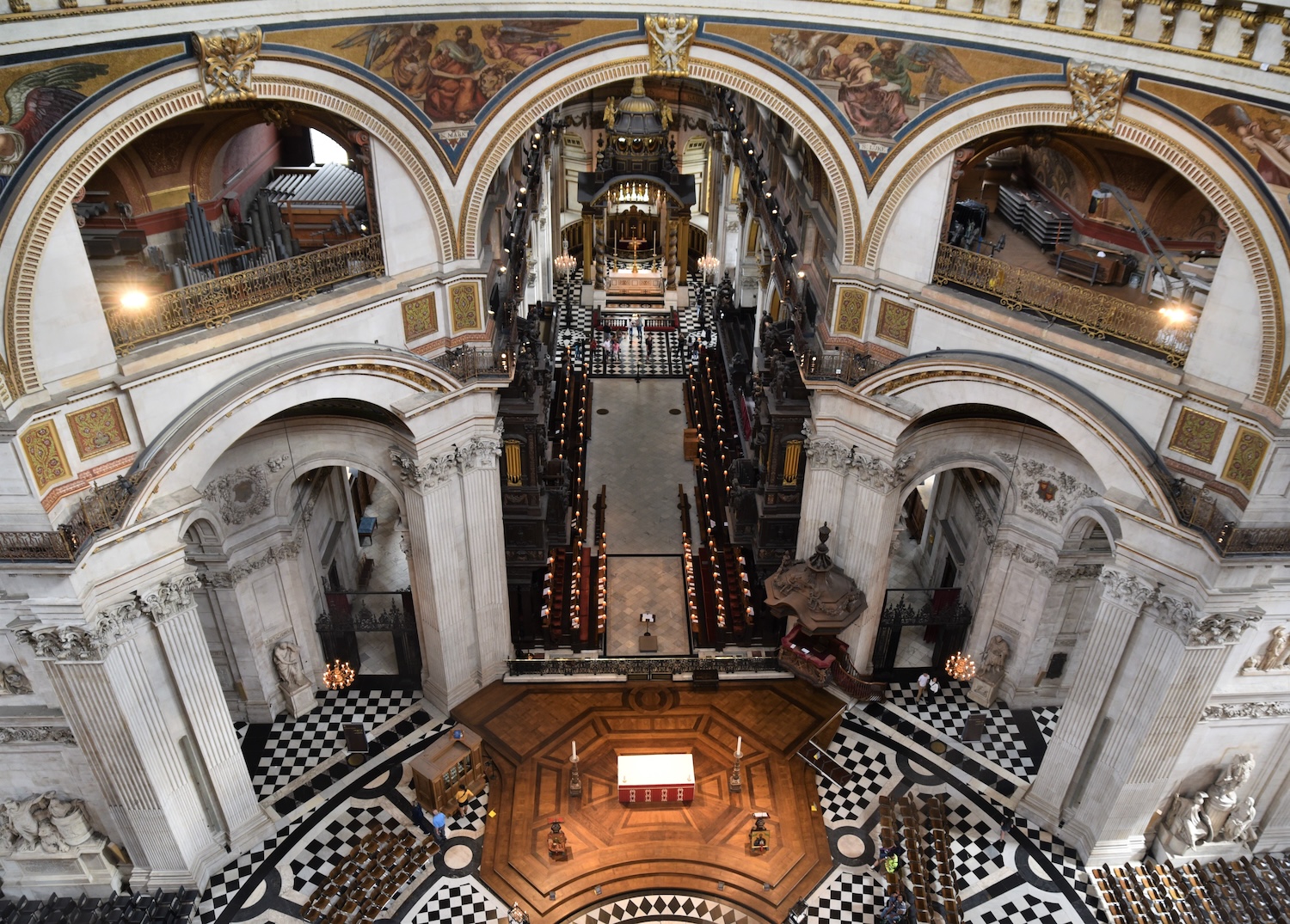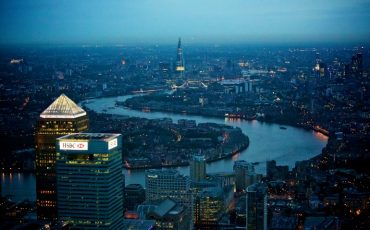It is no more than appropriate that in Sir Christopher Wren’s tercentenary, the star feature of his masterpiece, the Whispering Gallery at Saint Paul’s Cathedral, should have been re-opened after four years of renovation. London’s great sotto voce experience is back.
There has been no fanfare, no razzmatazz. Even the Visitor Engagement Team had only a day’s notice of the re-opening. The heart-pounding spiral ascent of 250 steps is not for all, and the vertigo-inducing parapet looks down onto the chequerboard marble tiles 364 feet below. No photography is permitted: a falling iPhone could kill a visitor underneath.
 he Geometric staircase at Saint Paul’s Cathedral in London. Photo credit: ©Peter Smith, St Paul’s Cathedral.
he Geometric staircase at Saint Paul’s Cathedral in London. Photo credit: ©Peter Smith, St Paul’s Cathedral.
The Whispering Gallery: A Unique Experience
Christopher Wren loved the idea of visitors exploring his masonry and climbing to hear the extraordinary acoustics of the building, the voices of choristers resonating in the upturned bowl, the organ echoing down the nave and amplified whispers hugging the walls. Other Wren creations offer similar opportunities. St Mary-Le-Bow has a balcony in the side of its tow from which to watch processions on Cheapside. The Monument is a spiral staircase inside a column up to a viewing platform where Londoners could watch their city being rebuilt in the decades after the fire.
Discreet netting now encloses the gallery, and a sequence of panels attached to Jean Tijou’s iron railing explains each of Sir James Thornhill’s eight gigantic monochrome paintings of scenes from the proselytising journeys of St Paul around the Mediterranean. You emerge after the climb facing east to see Paul’s dramatic conversion on the road to Damascus, the horses rearing, the soldiers panicking, and the voice of God thundering in a shaft of light from heaven.
 Whispering Gallery at Saint Paul’s Cathedral in London. Photo Credit: © St Paul’s Cathedral.
Whispering Gallery at Saint Paul’s Cathedral in London. Photo Credit: © St Paul’s Cathedral.
The Paintings of the Whispering Gallery
Moving clockwise, Paul is in Cyprus, blinding a disbelieving sorcerer who fumbles for his book with his guide dog yapping; then in Turkey, where pagans mistake Paul for a god and sacrifice a bull to him; Philippi, where he lands in jail during an earthquake which bursts the doors – no one escapes and the grateful jailer, on the point of suicide, converts. After that, Paul is in Athens, informing gentile stoics that we are all one and God is peculiar to no race; then Ephesus, where idolatrous texts are burnt, and Caesarea, where, imprisoned again, Paul explains Christianity to King Herod, who is impressed and can see no reason for Paul’s confinement but decides nonetheless to keep his Jewish faith. In the final painting, Paul is shipwrecked on Malta and survives a viper’s bite, at which miracle, the admiring Maltese convert.
Between the eight paintings are the supporting ribs of the 40,000-ton dome. They are disguised by statues in niches of the eight fathers of Christianity, four for the Eastern church (Greek and Russian Orthodox) – Athanasius, Chrysostom, Basil and Gregory The Theologian, and four for the Western church – Ambrose, Jerome, Augustine of Hippo and Gregory The Great. These are mighty figures who dominated the early years of the religion. Augustine of Hippo wrote the Te Deum, the oldest non-Biblical Christian text and is not to be confused with Augustine, who converted the Anglo-Saxons in 597 AD, a relatively minor figure in church history. The western Gregory invented Gregorian chant, and the eastern one defined the trinity.
 View from the Whispering Gallery at Saint Paul’s Cathedral in London. Photo Credit: © Saint Paul’s Cathedral.
View from the Whispering Gallery at Saint Paul’s Cathedral in London. Photo Credit: © Saint Paul’s Cathedral.
Christopher Wren: The Quest for Knowledge Exhibition
The wonder of the dome though is aural, not visual. Wren’s achievements and personality are celebrated in Quest for Knowledge, a free exhibition in the crypt marking 300 years since the death of the architect. One is greeted by a plaster 1683 bust of Wren when he was in his fifties, yet his look is youthful, open and intelligent, his eyes wide, his grin mischievous, his long hair seemingly his own. The sculptor Edward Pierce was part of Wren’s team and worked on many of his church interiors, including St Lawrence Jewry, St Clement Danes and St Andrew Holborn – as well as St Paul’s.
The exhibits at Saint Paul’s Cathedral include touching personal items like Christopher Wren’s penknife and other tools. There is a focus on his little-known medical research, including his injecting drugs into animal veins and his anatomical drawings of a flea and the human brain. There are archive pictures of London before and after the fire and one of The Monument at the head of London Bridge in its pre-1830 position.
Finally and rather amusingly, there is a display by local schoolchildren of their own designs for St Paul’s today and, to keep the young mind engaged, hands-on exhibits like the stonemason’s cap or the opportunity to savour the caustic whiff of the burnt-out city. Raise the alarm! That’s not for whispering.
 St Paul’s Cathedral in London. Photo Credit: © Ursula Petula Barzey.
St Paul’s Cathedral in London. Photo Credit: © Ursula Petula Barzey.







Leave a Reply